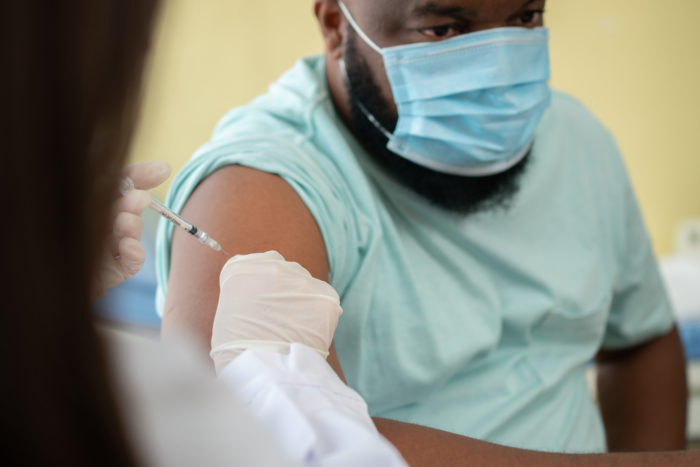Understanding the Impact of COVID-19 on Diverse Populations
Insights and Strategies for Inclusive Emergency Management From Cities on the Frontlines
Date: August 19, 2021

NAE has released the findings of a five-city COVID-19 Community Impact Survey designed to gather insights directly from Black, Indigenous, and other People of Color (BIPOC) and immigrant residents about the impact of COVID-19 on their economic and social well-being and sense of belonging. The survey effort, funded by the Walmart Foundation, reached more than 2,100 residents across the cities of Atlanta, Austin, Denver, Louisville, and Tulsa.
Key Findings:
- BIPOC and immigrant respondents reported facing significant financial hardship as a result of COVID-19. Nearly one-third of BIPOC and immigrant respondents lost a job, while more than 34 percent had their work hours reduced. Certain groups were even more likely to have reduced work hours, including Black or African American residents (39.1%) and immigrants without a college degree (38.0%), while refugees and asylees were most likely to have lost a job (34.8%).
- As a result of layoffs, reduced hours, and pay cuts, many BIPOC and immigrant respondents were worried about meeting basic expenses, with some facing eviction. More than half of BIPOC and immigrant respondents were worried about paying utilities in the coming month, and more than one third were worried about paying for healthcare, food, and emergency expenses. More than one out of 10 BIPOC and immigrant respondents were behind on rent or mortgage payments, and roughly 3 percent had been evicted or were facing eviction or foreclosure.
- Despite these challenges, many low-income BIPOC and immigrant respondents failed to receive stimulus payments from the federal government. Nearly half of BIPOC and immigrant respondents with household income below $20,000 reported that they did not receive a stimulus check. For BIPOC and immigrant households earning between $20,000 and $40,000 each year, at least one in four failed to receive stimulus checks.
- The largest U.S. cities are implementing a variety of strategies to meet the needs of BIPOC, immigrant, and limited English proficient residents — including those excluded from federal relief. Among nearly 50 cities surveyed, the majority of them reported sharing emergency information in multiple languages (46 cities), providing access to medical services regardless of immigration status (43 cities), supporting small business owners with access to relief grants, loans, and other assistance (44 cities), and providing cash and other forms of financial assistance to excluded workers and families (36 cities).
- Efforts by municipal governments and local organizations to address gaps in access are reaching the target communities, though obstacles remain. The vast majority of respondents (70%) reported receiving adequate help from local governments to protect themselves from COVID-19 and prevent its spread, and many reported receiving other City support services to secure food (42%), rent or mortgage assistance (12%), and other bill payments (7%). Additionally, more than 60 percent of respondents reported that there was a local organization they could turn to if they needed help. At the same time, less than one third reported receiving sufficient support to have a safe work environment, receive necessary medical care, and meet other essential needs.
- Lack of information, fear of bias attacks, and concerns about immigration status prevented many BIPOC and immigrant residents from seeking medical services like COVID-19 testing. Among BIPOC and immigrant respondents who said they or their family member felt sick with COVID-19 symptoms but did not get tested, more than four out of ten said that they lacked information about testing locations, and 17 percent reported fearing that they would be blamed or attacked due to their race. Additionally, 12 percent of immigrants said they did not get tested because they feared it could hurt their immigration status.
- Limited English proficient (LEP) immigrants faced some of the highest barriers to accessing services and were more likely to rely on informal sources for information about COVID-19. Nearly half of LEP respondents (47.6%) said they lacked information about testing locations, 28.2 percent said they lacked health insurance, and 16.4 percent did not get tested because they feared it could hurt their immigration status. LEP respondents were more likely to get information about COVID-19 from social media (41.1%) or family and friends (32.4%) than from the federal (26.0%) or their state (25.2%) government.
In addition to direct economic and health consequences, many respondents reported negative impacts on their sense of safety, well-being, and belonging. More than 30 percent of BIPOC and immigrant respondents reported a negative impact on their wellbeing, such as suffering from mental health issues like anxiety or depression, or experiencing financial distress due to job losses or fear of falling behind on payments. More than one out of four reported that COVID-19 hurt their sense of belonging, including heightened experiences of isolation, division, or racial tension in their communities.
Read the full report, Understanding the Impact of COVID-19 on Diverse Populations: Insights and Strategies for Inclusive Emergency Management from Cities on the Frontlines.
Results from the COVID-19 Community Impact Survey also informed the development of a new Inclusive Emergency Management component to the New American Economy Cities Index, to help cities assess key policies and practices in place to better prepare for and recover from future disasters. Conducted annually, the NAE Cities Index is a tool that measures immigrant inclusion through an assessment of local policies and socioeconomic disparities between the U.S.-born and foreign-born. Starting in Year 4, which will be released this fall, the NAE Cities Index will measure local policy and practice across six categories: Government Leadership, Economic Empowerment, Inclusivity, Community, Legal Support, and Inclusive Emergency Management. For more information visit NAE Cities Index.






